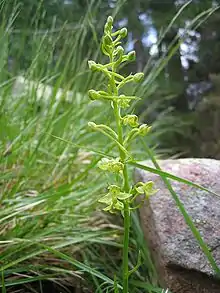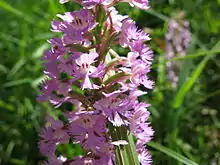Platanthera
The genus Platanthera belongs to the subfamily Orchidoideae of the family Orchidaceae, and comprises about 100 species of orchids. The members of this genus, known as the butterfly orchids[2][3] or fringed orchids,[4] were previously included in the genus Orchis, which is a close relative (along with the genus Habenaria). They are distributed throughout the temperate regions of the Northern Hemisphere. They are terrestrial and have tubercules.
| Platanthera | |
|---|---|
.jpg.webp) | |
| Platanthera bifolia | |
| Scientific classification | |
| Kingdom: | Plantae |
| Clade: | Tracheophytes |
| Clade: | Angiosperms |
| Clade: | Monocots |
| Order: | Asparagales |
| Family: | Orchidaceae |
| Subfamily: | Orchidoideae |
| Tribe: | Orchideae |
| Genus: | Platanthera Rich. |
| Type species | |
| Platanthera bifolia | |
| Synonyms[1] | |
| |
Etymology
Louis Claude Richard chose the name Platanthera for this genus; it comes from the Greek and means "broad or wide anther," referring to the separation of the base of the pollinia in the type species of the genus. Richard felt that this characteristic distinguished the genus Platanthera from both the genus Orchis and the genus Habenaria. However, today the defining characteristics of the genus are generally accepted to be the absence of both stigmatic processes (typical in Habenaria) and ovoid root-tuberoids (characteristic of both Habenaria and Orchis). Still, P. nivea, P. clavellata and P. integra all have stigmatic processes, showing the limitations of morphological characteristics in defining this clade.
Description and habitat
Species of Platanthera are perennial terrestrial herbs, erect in habit. The roots are fasciculate and typically fleshy and slender, although they may be somewhat tuberous; if tuberous they are lanceolate to fusiform and not ovoid. The leaves are generally fleshy and range from oblong or ovoid to lanceolate. Leaf shape often varies with the lower leaves more ovoid in shape, progressively becoming more lanceolate as they progress up the scape; floral bracts, if present, are lanceolate to linear. The base of the leaves typically sheathes the stem. The inflorescence is terminal and solitary, and the flowers form a cylindrical spike that ranges from sparse to dense. The flowers are typically resupinate, and often showy and colorful. The petals and labellum are typically entire, but in a number of North American species they may be fringed or edentate; in this group of species the labellum is also often deeply lobed or auricuate. The seed capsules are cylindrical and ridged.
These terrestrial orchids develop in a wide range of soil types and habitats, from strongly basic soils to deeply acidic bog soils, from forest openings and in clearings within the forest to open tundra. In all cases they require moist soils and are not found in dry or desert locations. While their fleshy tuberculous roots can store water, allowing them to survive temporary drought, they cannot survived extended drought.
Platanthera may be distinguished from Orchis and Habenaria by the absence of stigmatic processes, and the absence of ovoid roots.
Some Platanthera species are pollinated by mosquitoes.[5]
Species
Many species can cross-fertilise, resulting in great morphological variety and complicating classification.
The type species is Platanthera bifolia. More than 400 species, subspecies, and varieties have been described, and a 1997 study estimated around 85 species were clearly defined,[6] though these quantities vary considerably between evolving classification systems, and naturally change as specimens are reanalyzed or newly acquired.[2] "Species of Platanthera occur in North America, Asia, Europe, North Africa, Borneo, and Sarawak. Major centers of diversity are found in North America and East Asia."[6]
These include 52 species from temperate Asian countries (China, Japan, Korea, Taiwan), 13 species from tropical Asian countries (Burma, Indonesia, Papua New Guinea, the Philippines), 37 species from North America north of Mexico, 7 species from Europe.
They include:
- Platanthera algeriensis (Europe, North Africa)
- Platanthera aquilonis (North America)
- Platanthera azorica (Azores)
- Platanthera bifolia – greater platanthera[7] (Europe, Korea)
- Platanthera blephariglottis (North America)
- Platanthera brevicalcarata (Asia)
- Platanthera brevifolia (North America)
- Platanthera calceoliformis (China)
- Platanthera carnosilabris (China)
- Platanthera chapmanii (North America)
- Platanthera chlorantha (Europe)
- Platanthera chorisiana (Asia, North America)
- Platanthera ciliaris (North America)
- Platanthera clavellata (North America)
- Platanthera cristata (North America)
- Platanthera dilatata (North America)
- Platanthera flava (North America)
- Platanthera florenti (Asia)
- Platanthera fuscensis – Asian platanthera[7] (Asia, Korea)
- Platanthera grandiflora (North America)
- Platanthera holmboei (Asia, Europe)
- Platanthera holochila (Pacific)
- Platanthera hologlottis – white Asian platanthera[7] (Asia, Korea)
- Platanthera hookeri (North America)
- Platanthera huronensis (North America)
- Platanthera hyperborea (North America, Europe)
- Platanthera integra (North America)
- Platanthera integrilabia (North America)
- Platanthera japonica – East Asian platanthera[7] (Asia, Korea)
- Platanthera kuenkelei (North Africa)
- Platanthera lacera (North America)
- Platanthera leucophaea (North America)
- Platanthera leucostachys (North America)
- Platanthera limosa (North America)
- Platanthera macrophylla (North America)
- Platanthera mandarinorum – common Korean platanthera,[7] baby Asian platanthera[7] (Asia, Korea)
- Platanthera metabifolia (Asia)
- Platanthera micrantha (Azores)
- Platanthera minor – little platanthera[7] (Asia, Korea)
- Platanthera nivea (North America)
- Platanthera obtusata var. oligantha (Europe)
- Platanthera obtusata (North America)
- Platanthera okuboi (Asia)
- Platanthera ophrydioides – cloud Asian platanthera[7] (Asia, Korea)
- Platanthera orbiculata (North America)
- Platanthera pallida (North America)
- Platanthera peramoena (North America)
- Platanthera pollostantha[8] (Azores)
- Platanthera praeclara (North America)
- Platanthera psycodes (North America)
- Platanthera sachalinensis – big Asian platanthera[7] (Asia, Korea)
- Platanthera sparsiflora (North America)
- Platanthera stenochila X.H.Jin, Schuit., Raskoti & L.Q.Huang (Asia)
- Platanthera stricta (North America)
- Platanthera tescamnis (North America)
- Platanthera tipuloides (Asia)
- Platanthera ussuriensis – Ussuri river platanthera[7] (Asia, Korea)
- Platanthera yosemitensis (North America)
- Platanthera zothecina (North America)
Further reading
- Leroy-Terquem, Gerald and Jean Parisot. Orchids: Care and Cultivation. London: Cassel Publishers Ltd., 1991.
- Schoser, Gustav. Orchid Growing Basics. New York: Sterling Publishing Co., Inc., 1993.
- White, Judy. Taylor’s Guide to Orchids. Frances Tenenbaum, Series Editor. New York: Houghton-Mifflin, 1996.
- The Illustrated Encyclopedia of Orchids by Alec Pridgeon. Published by the Timber Press.
- The Manual Of Cultivated Orchid Species By Bechtel, Cribb and Launert, Published by The MIT Press.
References
- Kew World Checklist of Selected Plant Families
- Bateman, R. M.; James, K. E.; Luo, Y.-B.; Lauri, R. K.; Fulcher, T.; Cribb, P. J.; Chase, M. W. (2009). "Molecular phylogenetics and morphological reappraisal of the Platanthera clade (Orchidaceae: Orchidinae) prompts expansion of the generic limits of Galearis and Platanthera". Annals of Botany. 104 (3): 431–445. doi:10.1093/aob/mcp089. ISSN 0305-7364. PMC 2720662. PMID 19383726.
- "Butterfly orchid (Habenaria species)". Encyclopædia Britannica. Retrieved 11 December 2013.
- "Platanthera". Natural Resources Conservation Service PLANTS Database. USDA. Retrieved 7 October 2015.
- Peach, Daniel A. H.; Gries, Gerhard (2019). "Mosquito phytophagy – sources exploited, ecological function, and evolutionary transition to haematophagy". Entomologia Experimentalis et Applicata. n/a (n/a). doi:10.1111/eea.12852. ISSN 1570-7458.
- Hapeman, J. R.; Inoue, K. (1997). "Chapter 15: Plant-pollinator Interactions and Floral Radiation in Platanthera (Orchidaceae)" (PDF). In Givnish, Thomas J.; Sytsma, Kenneth J. (eds.). Molecular Evolution and Adaptive Radiation. Cambridge University Press. pp. 433–454. ISBN 978-0-521-77929-6.
- English Names for Korean Native Plants (PDF). Pocheon: Korea National Arboretum. 2015. p. 577. ISBN 978-89-97450-98-5. Archived from the original (PDF) on 25 May 2017. Retrieved 22 December 2016 – via Korea Forest Service.
- Bateman, Richard M.; Rudall, Paula J.; Moura, Mónica (2013). "Systematic revision of Platanthera in the Azorean archipelago: not one but three species, including arguably Europe's rarest orchid". PeerJ. 1: e218. doi:10.7717/peerj.218. ISSN 2167-8359. PMC 3869205. PMID 24392284.
External links
 Media related to Platanthera at Wikimedia Commons
Media related to Platanthera at Wikimedia Commons Data related to Platanthera at Wikispecies
Data related to Platanthera at Wikispecies- Platanthera Interactive Key at Utah State University
- Platanthera Fact Sheets
- Platanthera Interactive Key from Orchids of Wisconsin online Flora
- Platanthera picture database

